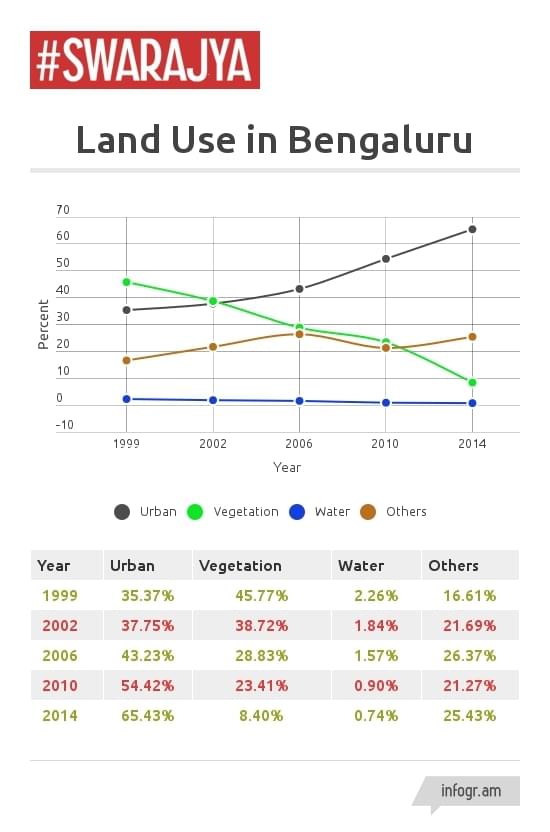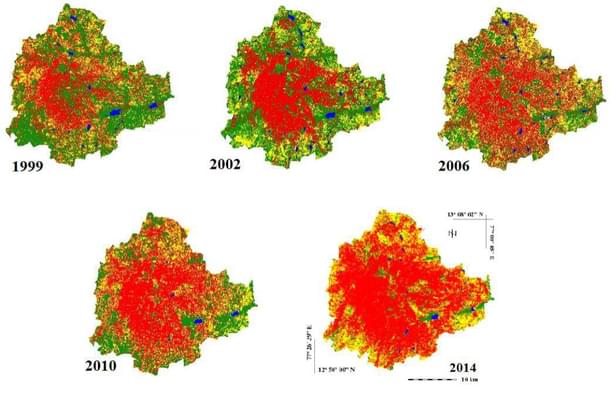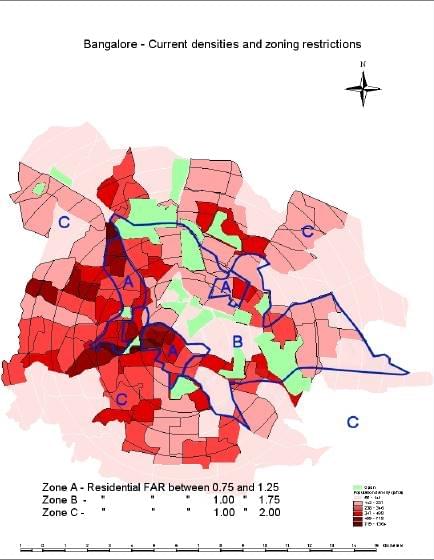Ideas
Is Bengaluru Really Dying In Five Years?
Shreyas Bharadwaj
May 23, 2016, 12:11 PM | Updated 12:11 PM IST
Save & read from anywhere!
Bookmark stories for easy access on any device or the Swarajya app.


- Policies aimed at ‘de-congestion’ of Bengaluru will make the city a bad place to live.
-
Sprawl is the reason Bengaluru has seen huge reduction in vegetation
and water bodies.
-
The city is made vibrant by its inhabitants.
Every year, sometime between April and May, citizens all over urban India get to read ‘expert’ opinions in newspapers as well as online news portals proclaiming that their city is dying. This year, during the aforementioned period, I happened to be in Bengaluru.
The news reports warning about the imminent death of this city were based on a conference paper by titled ‘Spatial Patterns of Urban Growth with Globalisation in India’s Silicon Valley’. The report quoted one of the authors of the paper, Prof. Ramachandra of IISc as saying : ‘What’s the point earning better when the food that you eat is adulterated? As a result of unplanned urbanisation, Bengaluru is going to be an unlivable and dead city in the next five years’.
Prof. Ramachandra blaming ‘unplanned urbanisation’ surprised me. The reason is the same study says that ‘BDA housing policies and other industrial housing colonies are responsible for the compactness in the center and sprawl in the outskirts’ and explains why sprawl is the reason Bengaluru has seen huge reduction in vegetation and water bodies. It was too much ‘planning’ by BDA and BBMP that that has contributed to this mess.

Prof Ramachandra goes on to say that ‘the government must take necessary steps to decongest Bengaluru. Besides banning new industries in the city, the government should make sure other districts get these economic benefits’.
There is absolutely nothing in the paper given as evidence to support the claim that ‘decongesting Bengaluru’ will solve the problem of a ‘dying’ city. A basic understanding of how Urban Land Markets function will enable one to conclude that it is the opposite case - congestion in city centres is a requiem.
The policy of state and local governments which aim at ‘decongesting’ the city centre is implemented by tight control of land use. Other restrictive constraints on land availability has lead to an urban sprawl as seen below-

One such instrument of control (or planning) is Floor Space Index i.e FSI (also called FAR). An FSI of 1 would mean 1000 Sq. feet of floor space is allowed to be built on a 1000 Sq. feet piece of land. It is effectively a restriction on the height of buildings and thus prevent land from being efficiently used. Nobody is allowed to build 1,00,000 Sq feet of floor space over 10,000 Square feet of land even if such a structure is financially and technically feasible. What it causes is higher rents and sale prices for Low FSI areas which as you shall see is usually in the city centre. It also causes people to move homes and businesses to higher FSI areas which as you shall see lie in the suburbs.
The zoning plan of Bengaluru divides the city into 3 zones: A, B, and C. The ‘Intensely Developed Areas’ come under Zone A. Moderately Developed Areas come under Zone B and Sparsely Developed Areas comes under Zone C . The FSI for residential areas as well as commercial areas are higher in Zone C and B than A. .
..the consequence of this (decongestion) policy is to discourage the redevelopment of the best accessible land in the city and to encourage the development of dense suburbsAlain Bertaud

The development of the suburbs i.e. sprawling instead of dense development in the city centres has a prominent side-effect : slow death of the forests and wetlands surrounding the cities. Now, you may be thinking, why was such a policy instituted in the first place ? The culprit is the ‘remedy’ Prof. Ramachandra has given for keeping our cities ‘healthy’ -State policy directed at the decongestion of the city centre.
As for the alarmist -’five years left until the city’s death’ declaration, the study nowhere mentions the five year figure. To be blunt, Prof. Ramachandra pulled the five year figure out of his hat. No city has ever died that suddenly. Bengaluru is too vibrant a city to die such a quick death.The city is made vibrant by it’s inhabitants which include the likes of Prof. Ramachandra. The city of Bengaluru has enough money and men to heal itself. There is no need whatsoever for such alarmist reports in the media.
To be continued.
Shreyas Bharadwaj is a Hindutvawadi from Mysuru who is interested in writing about cities and public policy.





